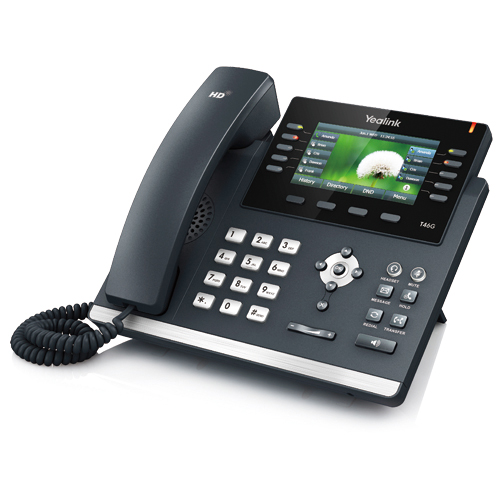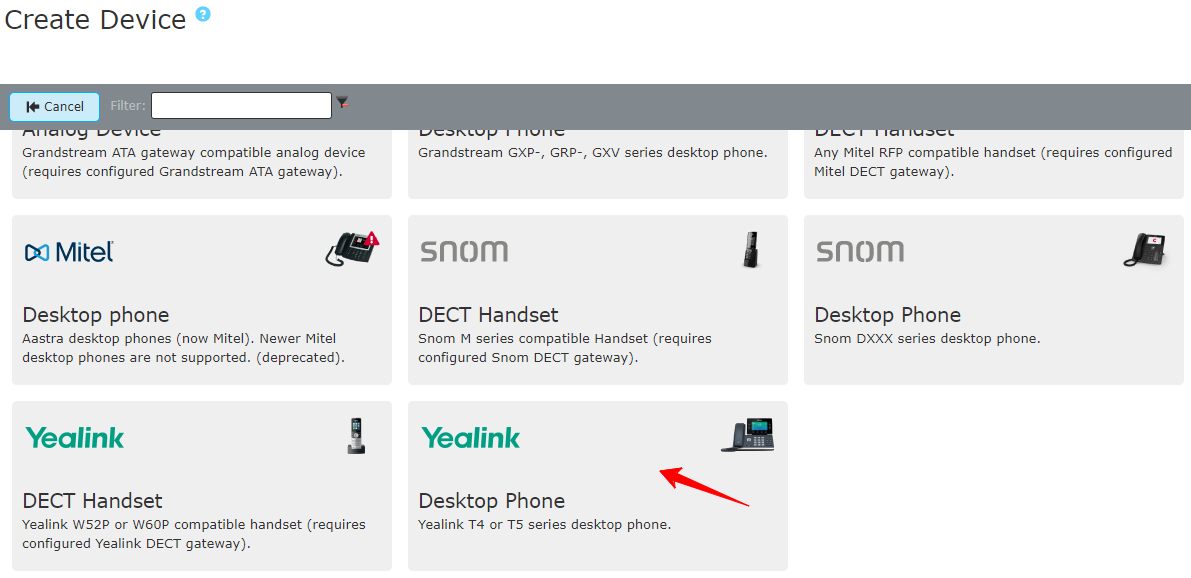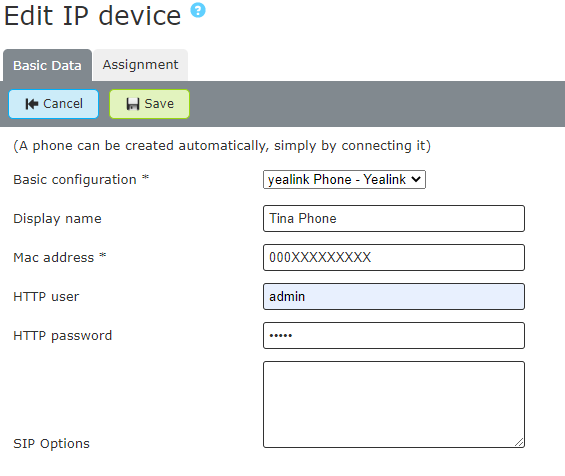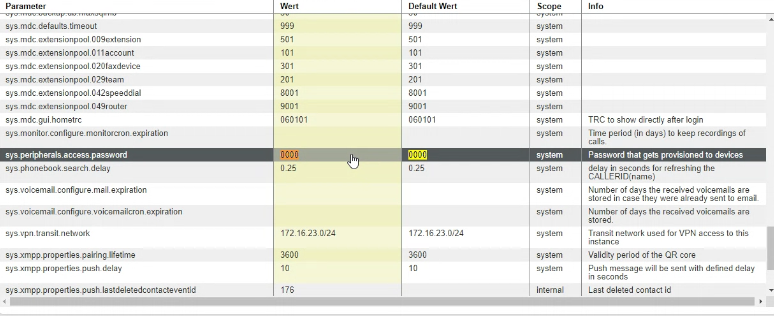Documentation
pascom Cloud Phone System Documentation and Release Notes
Yealink Desktop Phones
How to integrate your Yealink T4 or T5 Series Desktop SIP phones with your pascom phone system.
How to integrate your Yealink T4 or T5 Series Desktop SIP phones with your pascom phone system.

Supported Endpoints
| Models | |
|---|---|
| T4X | T5X |
| Provisioning | Firmware Management | Desktop Client CTI Control | pascom Menu |
|---|---|---|---|
| yes | yes | yes | yes |
Provisioning: The IP phone is managed via the pascom PBX web UI.
Firmware Management: Firmware can be managed and updated via the pascom PBX web UI.
Desktop Client CTI Control: The desktop UC client can remotely control the phone, i.e. to start calls.
pascom Menu: A button on the phone will be assigned to access the pascom menu.
Due to vast range of firmware versions available for the different IP telephones, it is not possible for us to test each version. Therefore, it could be the case that pascom does not support some firmware versions.
Yealink Provisioning
pascom phone systems are able to automatically and centrally configure Yealink IP phones. This process is known as Provisioning. For this purpose, pascom phone systems include a Default Configuration ( > ). For most deployment scenarios, these standard settings provide an ideal configuration. However, in some cases, the settings may need to be modified.
Add New Phone
1. Finding the MAC Address
MAC addresses can be found on the rear underside of the telephone.
Alternatively, the MAC address is often found on the product packaging.
2. Add Phones / Endpoints
Log into your pascom phone system and under > and press and select the option IP Telephone: Manufacturer Yealink.

Select a display name for the telephone.
Under the corresponding field, enter the Mac-Address that you have just found and noted.
To be on the safe side, use your own HTTP user and HTTP password data for the phone. This will overwrite the manufacturer’s default data during provisioning.

If you want to provision many endpoints, you can set a separate HTTP password globally for all provisioning in the system settings.

3. Assigning Users
As soon as the IP phone has appeared in the Device List, it can be edited via the button. Under the tab, the phone can be assigned to a user (or location)

4. Apply Jobs
After saving your phone setup configurations, a corresponding prompt to apply telephony configs will appear in the job box (top of the screen). Simply start the job by clicking on the .
5. Connect the Phone
Connect the phone to your network. Snom IP phones come with a built in switch, allowing you to connect the phone directly via the Ethernet port labelled as NET. Should you not have a PoE option available, connect the phone to a power supply.
Is the phone already integrated in your network?
- Restart the Phone.
Should the telephone not be factory new, ensure you perform a factory reset. In order to do this on the phone, power up the phone and then press holding the final until Factory Reset appears in the display. Confirm by pressing .
6. Function testing
The simplest method of testing whether a device has been successfully deployed is to call ones Voicemail box via *100. On successfully provisioned phones, you should now hear your Voicemail box prompts.
pascom Menu Key
Having been provisioned, the pascom menu key can be found on the second function key on the display of the Yealink IP phone. The following pascom phone system functions are available under this key:
| Function | Description |
|---|---|
| Telephone Book | Opens up the central pascom phonebook. |
| Journal | Displays answered, dialed and missed calls |
| Call Forwarding | Sets a call forwarding, activates / updates a previously configured call forwarding or deactivates an active call forwarding. |
| Voicemail Box | Voicemail box menu for activating/deactivating your mail box, plus message play backs |
| Login | Enables a user to log into the location where the phone is (Hotdesking / roaming users). |
| Logout [username] | Logs out the current user from this location. |
| Teams (Queues) | Is used for agent management within a queue (login, logout, pause..) according the configuration of the queue. |
Only set Call Forwardings via the pascom menu as they can then be managed by the PBX.
Using the DND key (Do Not Disturb) directly on your Yealink phone, ensures that the assigned user extension cannot be reached on the phone. The DND notice will appear only on the telephone itself and will have no impact on other endpoints or the Desktop UC client (softphone).
Accessing the Yealink Web UI
In order to access the web UI of your Yealink phone, you will need to know the phone’s IP address. The following outlines the different methods of discovering the phone IP Address:
Finding the IP-Address on the Telephone
Press the OK key when the phone idle screen is active and the phone IP address, MAC Address and firmware will be displayed.
Finding the IP-Address via the pascom Web UI Device Listn
Log into the PBX Web UI and select the > , which provides you an overview of all available devices. To the left of each entry is an Info symbol which when clicked will open an overview of the provisioned telephone including the IP address.
Function Keys
The function keys to the right and left of the Yealink phone’s screen support a 3 page view, meaning they can be assigned with 3 different functions one for each page. Should the first page be fully assigned, the last key (bottom right) can be used to toggle pages.
BLF Key User / Extension Monitoring
Using the function keys, it is possible to monitor other extensions (i.e. users). The BLF keys (Busy Lamp Field) can be used to provide status information relating to the monitored extension. In this scenario, monitoring means watching the extension to see if the user is currently on the phone, being called or to answer calls intended for this extension (call pickup).
Function Keys can be assigned in a variety of ways.
Assign Function Keys Direct on the Yealink Phone
Push and hold the function key on the phone which you wish to configure for 5 seconds. At this point you will be able to assign this key with a function (e.g. BLF key).
| Settings | Assignment |
|---|---|
| Type | BLF |
| Account ID | Line 1 |
| Label | Enter a name for the key. |
| Value | The extension to be monitored, e.g. 123 for the ext 123 |
To confirm, press Save.
Assign Function Keys via the Yealink Web UI
Under the tab it is possible to assign the various telephone keys as BLF keys for example:
| Type | Value | Label | Line | Extension |
|---|---|---|---|---|
| BLF | The extension to be monitored, e.g. 123 for extension 123 | Enter an label / name for the key. | Line 1 | The extension number, i.e. 123 |
As well as user extensions, it is also possible to configure a BLF key with login codes or extensions switches.
Further Useful Function Keys
| Function Key | Description | |
|---|---|---|
| Speed Dial | Can be assigned with a telephone number. | |
| DTMF | Can be assigned with DTMF characters. | –> |
Default Configuration
As previously stated, Yealink IP phones are provisioned using the default configurations which can be found under > .
When modifying the default configuration settings, ensure you make a duplicate copy of the original using the tool.
In addition, you can set an already edited default configurations as the . Doing so ensures that all newly added IP telephones will automatically be provisioned with these default configurations.
Assigning a Default Configuration
A default configuration can be assigned using multiple methods:
- Via > > Choose your Basic configuration set and press Under the tab, it is possible to add multiple IP telephones.
- Via > > Select and edit the IP Telephone and under the tab choose the correct Basic configuration option.
Default Configuration & Automatic BLF Assignment
Under the tab, it is possible to modify the existing basic configuration. Under the Keys section you will find the already pre-configured function keys which provide a useful guideline to work with.
BLF Keys can be setup as follows:
{{!-- keys -}}
linekey.3.type = 16
linekey.3.value = 123
linekey.3.label = Max
linekey.3.line = 1
The assigned key (in this case, line key 3) consists of three parameters:
- type: The key type, 16 stands for BLF,
- value: the value, in this case the extension number,
- label: the label, which is to be displayed on the phone’s screen Label.
- line: the account of the user who is logged in to the telephone and is performing the configuration. (selected line must always be 1)
Via the menu tab , assign these default configurations to thoses telephones that should be configured with this BLF setup. Save and apply your changes and once the phones have restarted, the changes will have taken affect.
Firmware Updates
From mobydick version 7.14 onwards, IP endpoint firmware will no longer be included as standard. Should a firmware version (other than the version pre-installed on the phone) be required, this must be externally sourced and per hand uploaded to the phone system firmware management tool.
Upload New Firmware
The desired firmware can be uploaded via the the > :
| Settings | Description |
|---|---|
| Firmware Files | Upload the firmware files here. Firmware can be found here: Yealink support download page. |
| Model | Yealink Telephone model name |
| Version | Firmware Version |
| Comments | Optional field for notes |
Firmware Roll Outs
Firmware updates can be roll out via the > menu. Simply select the desired Yealink Endpoints from the list via the check boxes and under > . This will open an overview of all selected devices to which the new firmware version should be roll out to. Click to roll out the desired firmware version.